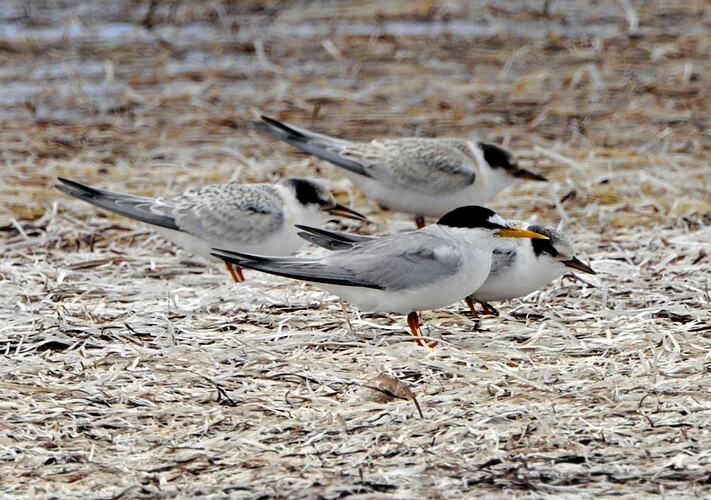General Description
Little Terns have grey and white plumage and a forked tail. Breeding season: adults have a solid black cap, white forehead, yellow legs and a yellow bill often seen with a black tip. The black mark in front of the eye reaches the bill. Non-breeding season: the bill becomes all-black, the legs are dark, the black mark in front of the eye retreats and the cap becomes a black band from behind the eye to the back of the neck leaving the crown white. Head to bill length up to 23 cm. Similar in appearance to the Fairy Tern.
Biology
Little Terns catch food by drawing their wings tightly to the sides of their body and plunging head-first into the water chasing their main prey which are small bait-size fish. Little Terns are beach-nesting birds that make a simple scrape in the sand laying two to three cream-coloured eggs blotched with black and dark brown. They are often seen nesting with similar looking Fairy Terns. These small birds are very susceptible to disturbance during the breeding season and their nesting colonies should be avoided. These are the smallest terns in Australia. Their voice is an excitable chatter, likened to lorikeets and are often seen before they are heard.
Distribution
Northern, eastern and south-eastern mainland Australia and Tasmania.
Habitat
Sheltered coasts, ocean beaches, bays, inlets and estuaries as well as near-coastal lakes and wetlands.
More Information
-
Animal Type
-
Animal SubType
-
Brief Id
A slender grey and white tern. The outer flight feathers are darker than the rest of the wing.
-
Colours
Grey, Black, White, Yellow
-
Maximum Size
23 cm
-
Habitats
-
Diet
Carnivore
-
Diet Categories
Fish, Crustaceans
-
Endemicity
-
Commercial
No
-
Conservation Statuses
CITES: Not listed, FFG Threatened List: Critically Endangered, EPBC Act 1999: Not Listed, IUCN Red List: Least concern
-
Taxon Name
-
Common Name
Little Tern
-
Kingdom
-
Phylum
-
Subphylum
-
Class
-
Order
-
Family
-
Genus
-
Species Name
albifrons

